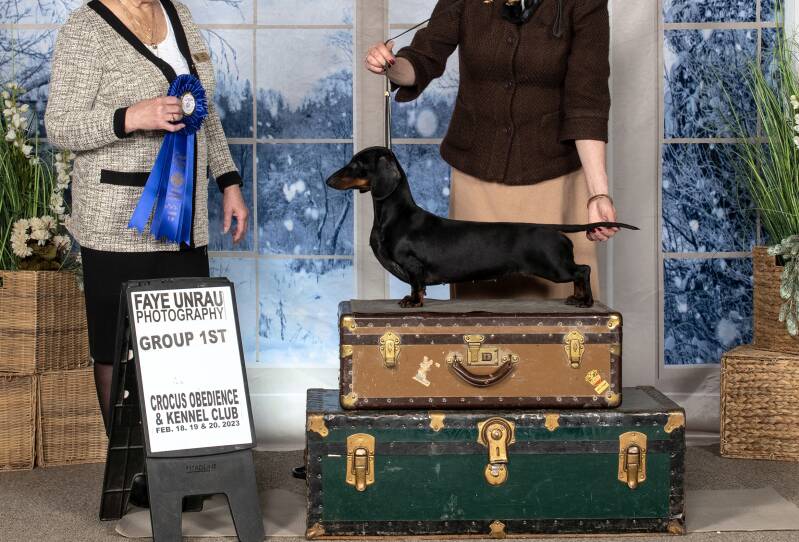HISTORY OF THE DACHSHUND & ITS JOURNEY TO CANADA
The Dachshund's history is a fascinating journey from a specialized German hunting dog to a beloved global companion.
INCEPTION IN GERMANY
-
Name and Purpose: The Dachshund originated in Germany, and its name, a literal translation of "badger dog" (German: Dachs meaning "badger" and Hund meaning "dog"), immediately reveals its original purpose.
-
Development: While dogs similar in type were known since the Middle Ages, the breed as we know it today was consistently developed by German foresters and hunters from the 17th to 18th centuries.
-
The Design: Their distinctive long, low body, short legs, and deep chest were deliberately engineered to enable them to dig into badger and fox burrows (called "going-to-ground"), follow the game, and confront them underground.
-
The Standard Dachshund was primarily bred for hunting larger game like badgers and wild boar.
-
The Miniature Dachshund was later developed in the 1800s to pursue smaller game like rabbits and hares in smaller tunnels.
-
-
Coat Varieties: The original type was the Smooth Dachshund. The Long and Wire varieties were developed later, with the latter possibly involving crosses with terriers and spaniels to enhance hunting qualities and provide better protection in rough terrain.

JOURNEY TO NORTH AMERICA AND CANADA
- Initial Arrival (c. 1880s): Dachshunds began arriving in North America, including Canada, around the 1880s. These early imports came from both Germany, the country of origin, and Great Britain, where Queen Victoria’s affection for the breed had made it a fashionable pet. Both German and British imports helped establish the breed on this side of the pond.
- The World War Setback: The popularity of the Dachshund suffered a severe setback in both the United States and Canada during the World Wars (especially WWI) due to its association with Germany. Owners often faced hostility, and some even renamed their dogs "Badger Dogs" or "Liberty Hounds" to try and avoid persecution. As Canada and the rest of the British Empire fought against Germany, public sentiment turned hostile toward anything perceived as German. The Dachshund, with its obvious German name and heritage, became a target of this anti-German propaganda.
-
Resurgence: Following the World Wars, dedicated breeders worked to re-establish the breed. Despite these efforts, the breed suffered immense hardship and a sharp decline in registrations as breeding programs were halted and public perception soured. The Dachshund eventually recovered its status and is now one of the most well-known and popular breeds in Canada, valued both as a versatile hunting dog and, more commonly today, as a loyal, spirited, and cherished family pet.

ARRIVAL AND EARLY RECOGNITION
-
CKC Recognition (1889): The breed was quickly recognized by the Canadian Kennel Club (CKC) in 1889, confirming its status as a distinct and established purebred dog in the country. This early recognition helped to solidify breeding efforts in the Country.
-
Early Breeding: Like in the United States, German and British imports initially dominated the show scene and breeding lines in North America, setting the early standard for the breed in Canada.
EVOLUTION IN CANADA
The Dachshund’s popularity was rebuilt in the decades following World War II, thanks to dedicated fanciers who focused on preserving the breed's physical standard and temperament.
-
Specialization and Classification: Unlike many other registries, within the CKC, the Dachshund is unique in that it is shown not as one breed but as six separate breeds in the Hound Group, based on size and coat:
-
Standard Smooth-haired
-
Miniature Smooth-haired
-
Standard Long-haired
-
Miniature Long-haired
-
Standard Wire-haired
-
Miniature Wire-haired
-
-
Canadian Breed Clubs: To maintain the integrity and health of these breeds, regional and national breed clubs were formed, such as the Eastern Canada Dachshund Club (ECDC) (formed in 1976) and the Federation of Dachshund Clubs of Canada (FDCC). These clubs are instrumental in promoting the breed standard, hosting specialty shows, and preserving the working heritage and unique appearance of the Dachshund breeds.
-
Modern Role: While still used for tracking, hunting, and "Earth Dog" work, the Dachshund in modern Canada has evolved primarily into a lively, spirited and loyal family companion. Canadian breeders continue to balance the original requirement for a courageous, tenacious hunting dog with the need for a sound, healthy, and affectionate pet, which contributes to its enduring popularity today alongside its unique "long-dog" appearance.